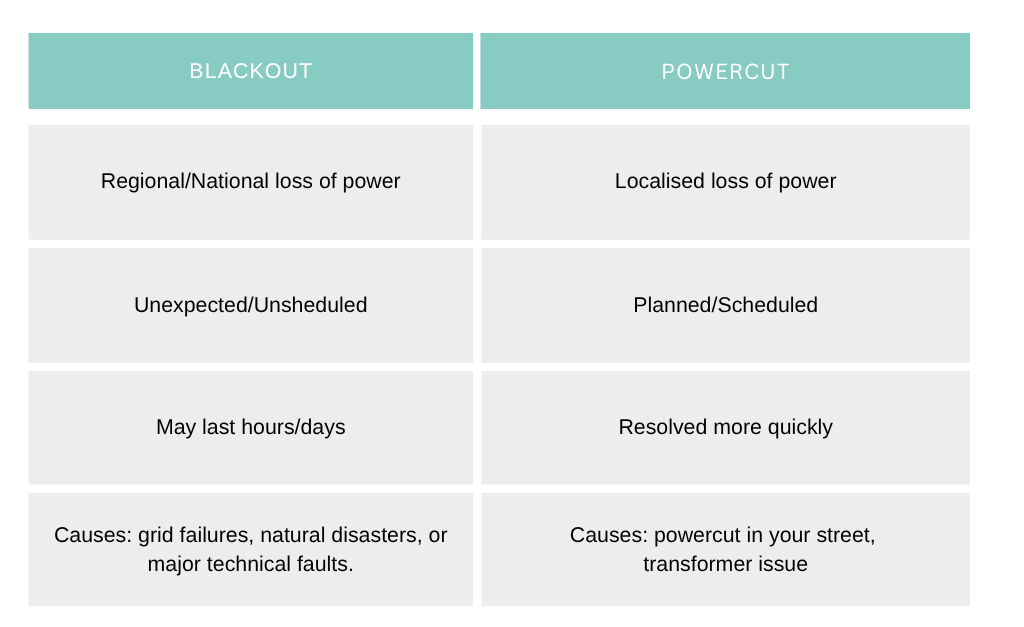UK Power Blackouts Warning – Am I At Risk?

The latest winter energy reports from NESO and National Gas highlight concerns about potential “tight days” this winter, along with warnings about the heavy reliance on imported energy. Concerns about a potential UK power blackouts warning for 2025 stem from various factors, including infrastructure vulnerabilities and recent energy supply disruptions. But how likely are they to occur?
UK Power Blackouts Warning – “Tight Days” Ahead!
The National Energy System Operator (NESO) which covers England, Scotland and Wales – said on Thursday, 9 October 2025, that electricity margins, which reflect the spare power supply available to meet customer needs, have risen to their strongest level since 2020. Which is good news. However, the report also highlights “tight days” that could lead to a potential UK power blackouts warning:
“We expect a sufficient operational surplus throughout winter, although there may still be tight days that require us to use our standard operating tools, including system notices,”
NESO manages supply issues to stop the UK running low on energy. It does this by balancing supply and demand in real-time by adjusting generation levels or requesting changes in consumption. To support this balance Neso also buys electricity e.g. from overseas through its balancing mechanism (BM).
NESO states that imports will be available as needed to meet demand, backed by “adequate electricity supply across Europe”.
But how much reliance can we place on imported electricity from Europe?
European Power Blackouts 2025
In April 2025, Spain and Portugal experienced nationwide blackouts lasting about 10 hours. A massive voltage surge disrupted public transport, leaving tens of thousands stranded, caused car accidents as traffic lights failed, and rendered emergency services unreachable.
The power surge in April 2025 was the most severe in Europe over the past 20 years. It was also the first recorded blackout due to overvoltage. This occurs when there is excessive electrical voltage in a network.
Spanish Electricity Gird Operaror- Red Eléctrica warns the country needs to take action urgently to manage fluctuations in energy and make significant adjustments to voltage management. Red Eléctrica attributed the blackout to coal, gas, and nuclear power plants failing to maintain proper voltage.
Meanwhile, the Spanish government, blaming poor planning by Red Eléctrica, along with power and grid companies, are conducting their own investigations.
The good news is the same issue is unlikely to happen in Britain. This is because NESO already mandates generators to manage voltage and fluctuations.
So what are the risks of a UK power blackouts warning for Winter 2025?
Is a UK Power Blackouts Warning Likely for Winter 2025?
According to the national electricity grid operator, Britain faces the lowest risk of a winter power blackout in six years. With levels of risk only lower during the pre-pandemic winter of 2019-2020 according to NESO.
NESO reports they have increased operational margins to 6.1 GW, the highest since the 2019/20 winter. This is 900 MW more than last year’s margins, roughly equivalent to three gas power stations. The improvement is attributed to new battery storage connections. Better availability of gas power stations, and the commissioning of the ‘Greenlink interconnector’ between Britain and Ireland. The Greenlink interconnector is a 190 km, 500 MW high-voltage direct current submarine power cable. The Greenlink connects Wexford, Ireland, and Pembrokeshire, Wales, and is capable of transmitting power in both directions.
Dr Simon Evans, deputy editor, senior policy editor at Carbon Brief advises:
“The UK has been trading electricity with France since the 1980s via a cable under the channel. There are now many more such cables, connecting the GB grid to other parts of Europe, including Ireland, Denmark, Norway, the Netherlands and Belgium. These cables help grid operators balance supply and demand, as well as meaning that consumers can take advantage of cheaper electricity supplies imported from other countries.”
However, the bumper energy margin achieved in the UK comes as energy prices are set to increase for the period of October to December 2025. Ofgem has raised the energy price cap by 2%, bringing it to £1,755 for a typical household. This is up from the previous quarter’s £1,720.
What Happens if the UK Starts Running Low on Energy?
NESO addresses supply challenges to prevent energy shortages in the UK by purchasing electricity through its balancing mechanism (BM), ensuring real-time balance between supply and demand.
NESO states that imports will be available as needed to help meet demand, backed by “adequate electricity supply across Europe.”
It can also issue an Electricity Margin Notice (EMN) to energy providers if UK energy levels are running low. Additionally NESO can request large industrial customers to lower their power consumption. In cases of national energy shortages NESO can also request Energy suppliers to reduce public energy usage during specific times.
In very rare and extreme situations, NESO may implement emergency powercuts, to prevent damage to the electricity network. When power cuts are unavoidable, those effected will be notified by their energy providers. You can also check online at the National Grid powercut outages map to view real time information on effected areas.
Blackout or Powercut- What’s the Difference?
Blackouts happen when the power grid fails unexpectedly, while selective power cuts are planned outages meant to prevent blackouts.
In the UK, blackouts typically last just a few hours, though they can sometimes extend to a day or more. Planned powercuts last for a shorter period and are easier to resolve.
A UK Power survey from 2023 revealed that 66% of people in the UK have experienced a power cut at some point. Although they remain relatively rare. Grid operators use planned power cuts as a last resort after trying every option to boost supply. These cuts give operators time to address the issue while minimizing the risk of sudden blackouts. Protecting critical buildings and infrastructure like hospitals, schools, and trains.
Households are usually notified in advance about planned power cuts. Any planned for loss of power generally takes place during low-demand times. A power cut generally lasts around 95 minutes on average. Ofgem confirms power cuts occur around once every two and a half years per area.

Deborah Petterson, director of resilience and emergency management at NESO, said:
“A resilient and reliable energy supply is fundamental to our way of life.
“At NESO we are looking at the upcoming winter and can report this year’s winter outlook sets out the strongest electricity margins in six years.
“It is critical that we continue our work with the wider energy industry to prepare for the coming months to build on this foundation and maintain our world-leading track record of reliability.”
The Main Causes of Blackouts:
Blackouts happen when there’s a big mismatch between electricity supply and demand usually caused by power stations unexpectedly shutting down. This happens when a plant disconnects from the grid and stops sending electricity. This can occur due to faulty equipment, extreme weather, or errors made by the people operating or maintaining the network. It typically takes two major power stations shutting down simultaneously for the grid to run out of reserve power to stabilise the frequency, but this is a rare occurrence.
So what are other areas of concern when assessing if a UK power blackouts warning will occur this Winter?
Energy Supply Disruptions
In June 2025, a major system shutdown impacted around 250,000 households as the Radio Teleswitch Service (RTS) was phased out. This change may cause further problems with heating and hot water for people using older electricity meters.
Infrastructure Vulnerabilities
The UK’s undersea cables, vital for power and communication, such as the Greenlink, face potential sabotage threats. Experts caution that such an attack could trigger widespread blackouts and disruptions to essential services.
How Can Renewable Energy Help?
In the first half of 2025, renewable energy overtook coal in generating the world’s electricity for the first time. In Britain, renewables like solar and wind contributed a record 54.5% of power in the three months leading up to June.
Increased renewable energy use can lead to lower bills by reducing dependence on the volatile oil and gas markets, which have stayed high following the invasion of Ukraine and efforts to move away from Russian fossil fuels. Jess Ralston, an energy analyst at the Energy and Climate Intelligence Unit (ECIU) thinktank said:
“Renewables are lowering wholesale electricity prices by up to a quarter”
The best way to stay prepared for a blackout is to have a backup power source ready for when the grid goes down. However, most solar and battery systems will automatically shut off during a blackout to prevent exporting power to the grid, which could endanger engineers working on the power lines.
Whole Home Back Up Batteries
You can avoid this situation by going completely off-grid or using a battery with whole home back up functionality provided by a Gateway. A gateway will temporarily transfer the home off grid during a power outage, allowing your home battery to provide power to your home using the energy it has stored. If Solar panels are also connected via a Hybrid inverter to the battery storage system, you can also use surplus Solar generation to top up your battery storage whilst the outage continues. This is assuming the outage is occurring during the daytime, if the outage occurs at night-time you would require enough stored energy to see you through the night until sunrise . Look for batteries with automatic switchover capabilities for seamless operation during outages. Popular choices with integrated whole home back up options include:
- Sigenergy (with Gateway)
- Tesla Powerwall (with Gateway)
- Hanchu (limited to 32A 5kW power output)
- Enphase (with IQ controller)
- Fox (with Gateway)
Reducing dependence on the grid is a smart move for reasons beyond just power cuts. Solar panels aren’t just an environmentally friendly choice; they can save you significant money in the long term. With increasing energy prices in the UK, many homeowners find they can recoup their initial investment in as little as 6-10 years, especially when paired Smart Export Guarantee tariffs and battery storage systems.
How Can E-Verve Energy Help?
If you’re interested in exploring gateway battery storage to protect your home against power outages or if you’re simply curious about how much savings solar panels and battery storage could save you on your energy bills use our simple online quote builder below.
Get your solar cost upfront with no pressure to commit and see how much solar panels could save on your bills. We’re here to help you find the perfect setup for your home!
E-Verve Energy is an MCS accredited, TrustMark approved Solar Installer and proud members of leading consumer protection bodies RECC and CPA. We are officially The Most Trusted Renewable Energy Installers of 2024 and with over 10 years in the Industry your in safe hands! What this means for you:
Get Your Custom Solar Quote in Minutes
Select your setup and receive your tailored solar quote instantly.
120+ Google Reviews
